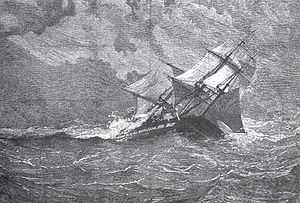HMS Eurydice (1843)
 HMS Eurydice sinking off the Isle of Wight, Illustrated London News. | |
| Career | |
|---|---|
| Name: | HMS Eurydice |
| Namesake: | The nymph Eurydice, wife of Orpheus |
| Ordered: | 27 August 1841 |
| Builder: | Portsmouth Dockyard |
| Cost: | £16,137, plus £9,312 for fitting out |
| Laid down: | April 1842 |
| Launched: | 16 May 1843 |
| Completed: | 1 September 1843 |
| Commissioned: | 27 June 1843 |
| Recommissioned: |
30 May 1846, 4 April 1854, 7 February 1877 |
| Fate: |
Foundered in 1878 Salvaged and broken up that year |
| General characteristics | |
| Type: | Corvette |
| Tons burthen: | 910 81/94 bm[1] |
| Length: | 141 ft 2 in (43.03 m) (gundeck)[1] 117 ft 9.75 in (35.9093 m) (keel) |
| Beam: | 38 ft 10 in (11.84 m) |
| Sail plan: | Full-rigged ship |
| Complement: | 190[1] |
| Armament: | Rated for 26 guns
|
HMS Eurydice was a 26-gun Royal Navy corvette which was the victim of one of Britain's worst peace-time naval disasters when she sank in 1878.
Origins of Eurydice
Designed by Admiral the Hon. George Elliot, the second Eurydice was a very fast 26-gun frigate designed with a very shallow draught to operate in shallow waters. She originally saw service on the North American and West Indies station between 1843 and 1846 under the command of her first captain, George Augustus Elliot (the eldest son of her designer). Under Captain Talavera Vernon Action, her second commission between 1846 and 1850 was spent on the South African ("Cape of Good Hope") station. Her third commission, under Captain Erasmus Ommanney (between 1854 and 1855) and then Captain John Walter Tarleton (1855 to 1857) saw her first sent briefly to the White Sea during the Crimean War and then to the North American and West Indies station again. The Eurydice saw no further seagoing service in the next twenty years; she was converted into a stationary training ship in 1861. In 1877, she was refitted at Portsmouth and by John White at Cowes for seagoing service as a training ship.
Loss of Eurydice
After being recommissioned under the command of Captain Marcus Augustus Stanley Hare, Eurydice sailed from Portsmouth on a three-month tour of the West Indies and Bermuda on 13 November 1877. On 6 March 1878, she began her return voyage from Bermuda for Portsmouth. After a very fast passage across the Atlantic, on 24 March 1878[2] Eurydice was caught in a heavy snow storm off the Isle of Wight, capsized and sank. Only two of the ship's 319 crew and trainees survived, most of those who were not carried down with the ship died of exposure in the freezing waters. Captain Hare, a devout Christian, after giving the order to every man to save himself, clasped his hands in prayer and went down with his ship.[3] One of the witnesses to the disaster was a young Winston Churchill, who was living at Ventnor with his family at the time.[4] The wreck was refloated later that same year but had been so badly damaged during her submersion that she was then subsequently broken up. Her ship's bell is preserved in St. Paul's Church, Gatten, Shanklin. There is a memorial in the churchyard at Christchurch, The Broadway, Sandown. The ship's anchor is set into a memorial at Clayhall Cemetery, Gosport.
Prelude to a second disaster
An inquiry found that the vessel had sunk through stress of weather and that her officers and crew were blameless for her loss. There was some adverse comment on the suitability of Eurydice as a training ship because of her extreme design, which was known to lack stability. However, she was immediately replaced by another 26-gun frigate of identical tonnage but slightly less radical hull-lines, HMS Juno. Ironically, Juno was renamed HMS Atalanta and made two successful voyages between England and the West Indies before disappearing at sea in 1880 with the loss of 281 lives; the ship is believed to have been lost in a storm. Later British seagoing training ships were smaller purpose-built brigs.
In literature
The Loss of the Eurydice is a major poem by Gerard Manley Hopkins.
Ghost ship
The phantom Eurydice has been sighted frequently by sailors over the years since her sinking. Most notably, on 17 October 1998, Prince Edward of the United Kingdom reportedly saw the three-masted ship off the Isle of Wight while filming for the television series "Crown and Country", and the film crew claimed to have captured its image on film.[5] There is also a story from Commander F. Lipscomb of a royal naval submarine which took evasive action to avoid the ship only for it to disappear.[6]
References
- ↑ 1.0 1.1 1.2 Winfield, Rif & Lyon, David (2004). The Sail and Steam Navy List: All the Ships of the Royal Navy 1815–1889. London: Chatham Publishing. ISBN 978-1-86176-032-6. OCLC 52620555. p.115
- ↑ West, Jenny (1973). The Windmills of Kent. London: Charles Skilton Ltd. p. 51. ISBN 0284-98534-1.
- ↑ Agnes Weston: My Life among the Bluejackets, James Nisbett: London, 1909. Page 123
- ↑ Churchill, Winston (1930). My Early Life. New York: Touchstone. p. 6. ISBN 0-684-82345-4.
- ↑ Harding, John (2004). Sailing's Strangest Moments: Extraordinary But True Tales from Over 900 Years of Sailing. Franz Steiner Verlag. p. 92. ISBN 1861057458
- ↑ J.C Medland. "Shipwrecks of the Wight". Coach House Publications ltd, 2004
Sources
- David Lyon, The Sailing Navy List, All the Ships of the Royal Navy Built, Purchased and Captured 1688–1860
- The Times, various dates 1878.
External links
- Isle Of Wight Shipwrecks: Eurydice
- Memorials in St. Ann's Church, Portsmouth for HMS Eurydice's crew and passengers.
| Wikisource has original text related to this article: |